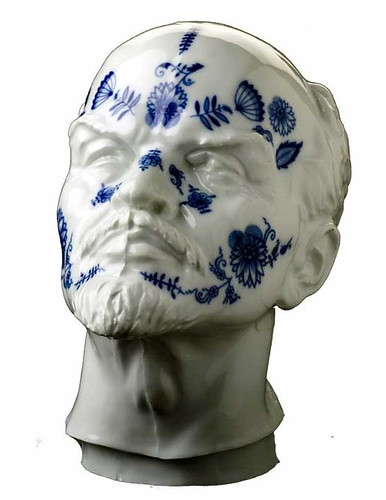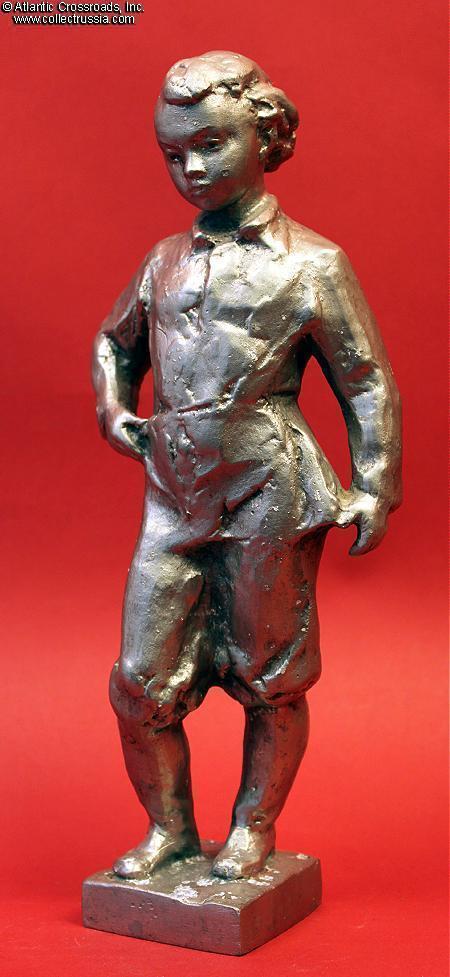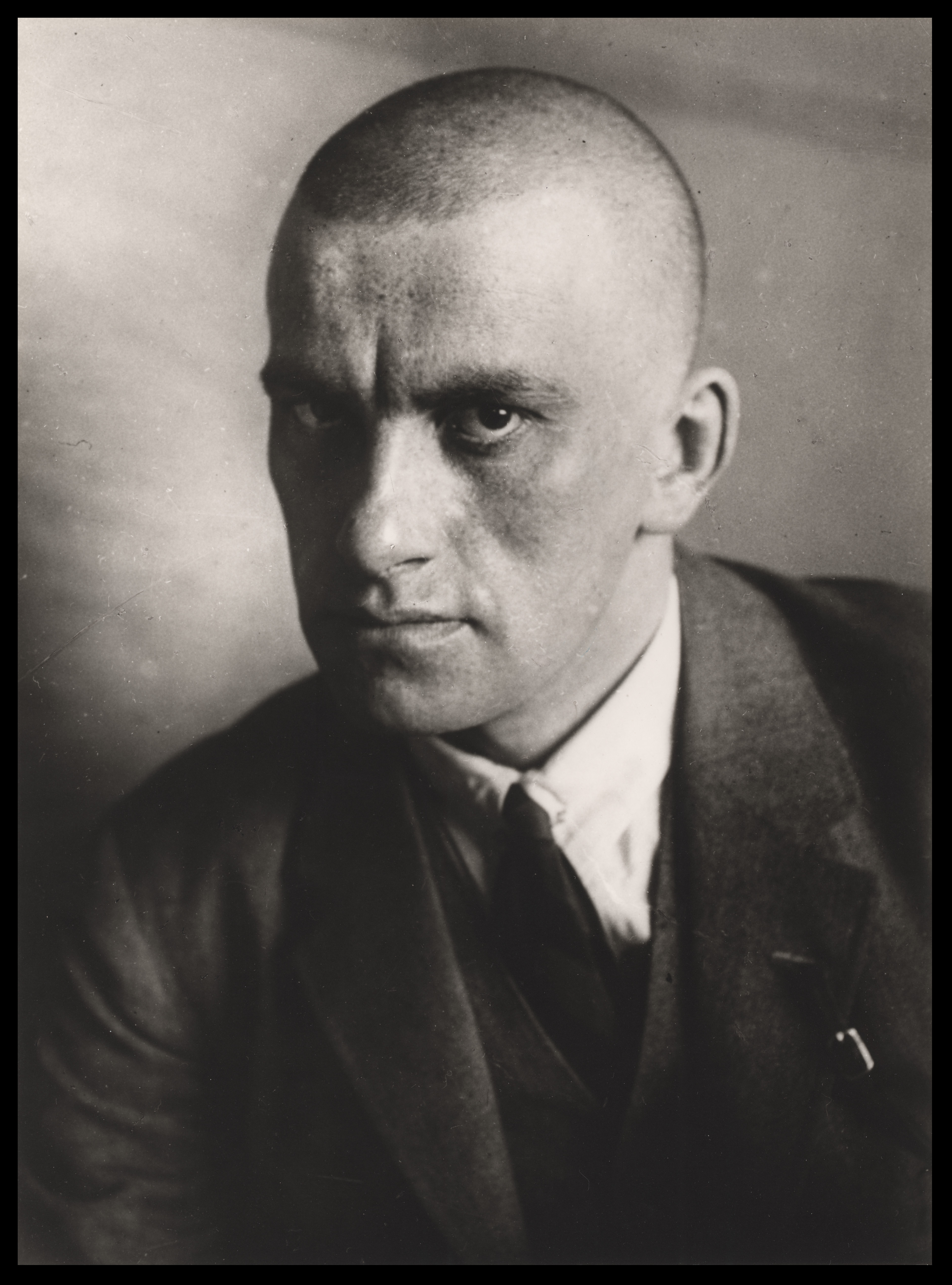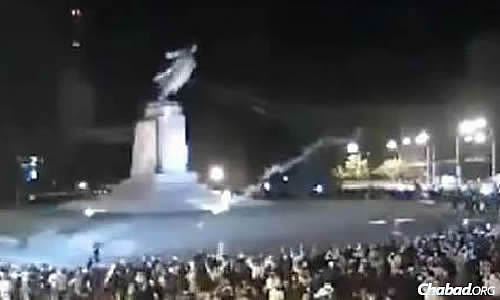 |
| Post-WW2 bust of Lenin covered in tradirtional Czech patterns |
In the beginning, immediately upon Lenin's death, no agency supervised or controlled the overall production of artistic renditions of Lenin. Produced in a hurry and often by men and women of little talent, they were often of very poor quality. It was not long before the Funeral Commission took notice of the problem. Ten days after Lenin's funeral, Leonid Krasin complained bitterly about the busts of Lenin that were popping up everywhere. Not a single one bore a satisfactory resemblance to the leader. On the contrary, they looked "simply repulsive". Some of these, Krasin continued angrily, should be destroyed on account of their "disgraceful, I should say even sacrilegious " lack of resemblance to Lenin. Even worse, he said in an article on monuments to Lenin, were busts that bore a partial resemblance to Lenin:
When the sculptor has managed to catch some single feature that reminds you of Vladimir Ilich, but in the rest of the portrayal there is nothing that looks like him, the result can be vulgar and shocking beyond description; instead of the exquisite incomparable head of Vladimir Ilich that has the most interesting structure since that of Socrates, before us is the head of some rickets-ridden shopkeeper or provincial lawyer.
"One is seized with fear" exclaimed Krasin at the thought that "hundreds of thousands of such busts" might appear throughout the country, and that "millions of people might forever imagine the features of Vladimir Ilich wearing the grimaces of these monstrosities".
Krasin insisted that the realization of this nightmare be prevented by government decree. His suggestion was speedily adopted. On April 24, 11924, the Central Executive Committee passed a decree prohibiting the reproduction, sale and public exhibition of portrayals of Lenin in all media (except photographs)... without the express permission of any one of a number of specifically named subcommittees of the Immortalization Commission... It ended with the warning that it was a criminal action to disobey the decree.
In Moscow the actual judging was done by the Immortalization Commission's executive committee or troika, which was also in charge of the construction of the mausoleum and sarcophagus for Lenin's body and the preservation of the body. Authorized portraits, posters and busts of Lenin were put up for sale and advertised... But if many individuals and institutions responded to the sale of Leniniana by buying it, there were some who deplored the practice. Its most strident and vocal critic was the renowned poet Vladimir Mayakovsky.
The author of a number of poems on Lenin, Mayakovsky was in the process of composing his most famous contribution to the cult of Lenin, the epic poem "Vladimir Ilich Lenin" when he came out with the plea "Don't traffic in Lenin!" ...
Mayakovsky objected not to the public celebration of Lenin, but to the cheap and vulgar form that celebration was taking. The cult of Lenin ... was sullying and destroying Lenin's immortal spirit. The editorial's first page provided a graphic illustration of the practice the poet found so distasteful, a reproduction of one of the many advertisements carried in the contemporary press:
BUSTS
OF V.I. LENIN
PLASTER, TREATED COPPER, BRONZE
MARBLE, GRANITE
LIFE-SIZED AND DOUBLE LIFE-SIZED
from the original approved for reproduction
and distribution by the Commission on the Immortalization
OF THE MEMORY OF V.I.LENIN
MADE BY THE SCULPTOR
S.D. MERKULOV [MERKUROV]
--------------- OFFERED BY ------------------
STATE PUBLISHING HOUSE
for state institutions, party and professional
*** organizations, coopertaives etc ***
EVERY COPY IS AUTHORIZED.
{Items may be] viewed and ordered
IN THE COMMERCIAL PUBLICATIONS DEPARTMENT
Moscow, Rozhdetvenka, 4
An illustrated prospectus will be sent out for free
on a first-come, first-served basis.
REPRODUCTION AND COPYING WILL BE
PROSECUTED ACCORDING TO THE LAW.
Mayakovsky then went into his dramatic content:
We are against this.
We agree with the railroad workers from the Kazan RR who asked an artist to decorate the Lenin hall in their club without busts and portraits of Lenin, saying : "we don't want icons."
We insist:-
Don't mechanically punch out Lenin.
Don't print his portraits on posters, on tablecloths, on plates, on mugs, on cigarette-cases.
Don't bronze Lenin.
Don't take from him his living acts and human aspect, which he was able to retain, while directing history.
Lenin is still our contemporary.
He is among the living.
We need him alive, and not dead.
Therefore,-
Learn from Lenin, but don't canonize him.
Don't create a cult around a person, who during his whole life fought against every kind of cult.
Don't traffic in the articles of that cult.
Don't traffic in Lenin!
Mayakovsky was not alone in deploring the gross impropriety of much of the Leniniana that appeared just after Lenin's death. As early as February 1924 the newspaper Rabochaia Moskva published a letter from a reader who complained that a Ukrainian cigarette factory was putting Lenin's portrait on cigarette packets. The unfortunate result, he said, was that the empty boxes littering the streets were trod upon by the pedestrians who were unwittingly stepping on Lenin's face. the authorities moved to prevent such abuses of Lenin's image. In May 1924 the Immortalization Commission published a resolution informing all enterprises that the printing and distribution of Lenin's portrait on cigarette boxes and wrappers, candy wrappers and candy, labels for products of any sort, and all jewelry was "categorically forbidden".
 |
| Lenin as a schoolboy. |









